Downton Abbey: A New Era is now in movie theaters, and I’m reliving my exciting visit to Highclere Castle in 2012.
I admit it: I’m among the millions who are enthralled by the hit PBS television series, Downton Abbey, set in England during the early 20th century. We Downton Abbey fans are fascinated by the escapades of the Granthams and Crawleys, who live in an opulent country manor house.
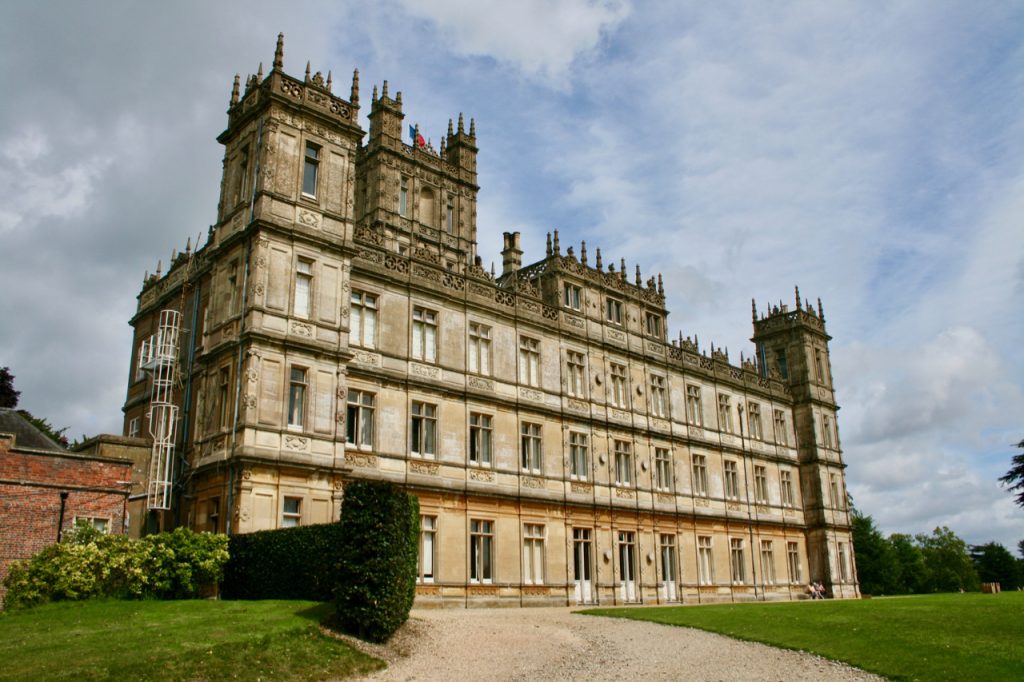
Catching the first glimpse of Highclere Castle—the film location for the Downton Abbey TV series and films—literally took my breath away. ©Laurel Kallenbach
So, as I was planning vacation in southwest England in 2012, it made sense that my husband and I should seek out the real Downton Abbey: Highclere Castle. This beautiful estate—set on 1,000 acres of parkland in Berkshire, England—about 1.5 hours west of London—is the film location for the “upstairs” scenes of Downton Abbey.
In case you’ve been living under a rock, Downton Abbey is a posh costume drama—OK, it’s really a souped-up soap opera—that follows the lives and romances of the aristocrats and servants who live in this lavish estate home. The story also jumped to the big screen and has, to date, two major motion pictures.
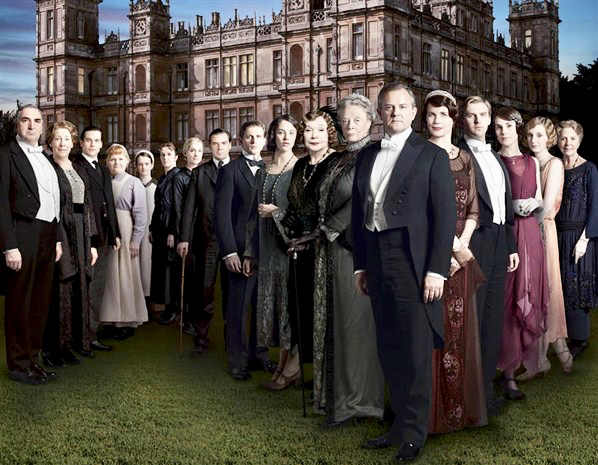
The cast of the Downton Abbey TV series, which airs on PBS
Meet the Carnarvons
In real life, the Carnarvon family has lived at Highclere Castle since 1679, and the history of the house rivals—and sometimes parallels—the dramatic storyline of the hit show that’s filmed there.
To get the scoop on the Highclere estate’s history before we traveled to England, Ken and I read Lady Almina and the Real Downton Abbey, penned by the current Countess Carnarvon, Lady Fiona, who is the Eighth Countess Carnarvon. The book contains many juicy historic tidbits—some of which are even more fantastic than the fictional TV show. Here are just a few:
- In 1895, Almina Wombwell married the estate-rich but cash-strapped George Herbert (the Fifth Earl of Carnarvon). Almina was the illegitimate child of the über-wealthy Alfred de Rothschild. Her generous dowry funded many improvements at Highclere Castle—and the tales of her shopping sprees are mind-boggling to us 21st-century commoners.
- During World War I, Almina, the Fifth Countess of Carnarvon, transformed Highclere Castle into a convalescent hospital for wounded soldiers—as did the fictional Lady Grantham and Mrs. C
rawley in the Downton Abbey television show.
- Lord Carnarvon, Almina’s husband, funded Egyptologist Howard Carter and was instrumental in discovering the tomb of King Tut in 1922. Some artifacts that Lord Carnarvon brought home from archaeological digs are on display at Highclere Castle.
This last fact really piqued my interested, as I’ve had a lifelong passion for ancient Egypt. I’ve known who Lord Carnarvon was since I was eight years old—so imagine my excitement when at Highclere Castle I saw old photos of Lord Carnarvon studying maps of Egypt’s Valley of the Kings in the same library where Downton Abbey’s Lord Grantham gives instructions to Mr. Carson, the butler.
A Tour of Highclere Castle
Since Downton Abbey’s premiere, visitation to Highclere Castle has quadrupled, so I reserved tickets online 90 days before our visit—to assure that it wouldn’t be sold out. (Highclere isn’t open to the public every day because it’s a private home. Tickets gain you entry for 2.5 hours either in the morning or afternoon. There’s a separate admission fee for the Egyptian exhibition.)
Our first glimpse of Highclere Castle was from the parking area; a bus was disgorging passengers. So we headed first to the loo, as we’d had an hour-long drive, which involved getting lost along the way. (What’s a pilgrimage without a long, winding road filled with travail?) In our case, we had to brave driving on the left side of the road, and we had to stop for directions twice. One sweet older man at a nearby village told us to cross the bridge, travel up the hill past the estate owned by Andrew Lloyd Weber (the composer of Phantom of the Opera, Evita, and Cats fame), and straight on until we saw signs.
Once inside the Castle, we ooh-ed and ahh-ed as we passed through the marvelous Entrance Hall into the Library with its gold-plated, leather-bound books; red carpets; and carved shelves. It’s odd when a place you’ve never been before seems so very familiar. Such is the theatrical magic of film.
Although there’s no formal tour at Highclere, each room has a knowledgeable docent who answers questions about the room. Several of them worked as stewards during Downton Abbey filming. Their job then—as it is while visitors stream through—is to be sure that nothing is disturbed or broken in the historic building while the light and camera crews are at work.
Highclere Castle’s Music Room is lined by beautiful tapestries displaying monkeys, rabbits, peacocks, and owls. This room isn’t used as a Downton Abbey setting, probably because it’s rather small, but it features a desk that belonged to Napolean.
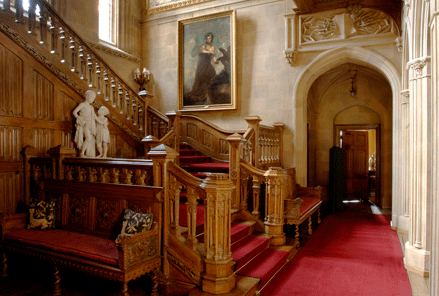
The regal Oak Staircase. Photo courtesy Highclere Castle
The Smoking Room doesn’t appear in the TV show either, but as the place where the men gathered after dinner, it was also the storage spot for a number of Egyptian artifacts. Funerary jars that were once used as umbrella stands are now in museums.
The lovely green-and-yellow Drawing Room, on the other hand, is the location for a number of scenes in Downton Abbey, as Lady Grantham and her daughters often meet there. During season 2 of the show, the wounded WWI soldiers slept on cots in this French-style room, which was decorated by Lady Almina in the early 20th century.
Throughout the house, tables and walls are covered with portraits of the Carnarvons—from the 17th through 21st centuries. The modern snapshots—far less formal than the paintings—are a reminder that this is still a private home.
There’s other evidence of modern use too. There’s a hair drier on the vanity in the Mercia Bedroom (Lady Grantham’s bedchamber on the TV show—much featured in the scenes in which she nearly died from Spanish flu). Occasional guests stay in the very bedrooms that are broadcast around the world.
The Stanhope Bedroom, decked out in red carpet and draperies, was the perfect setting for the scandalous television scenes involving the infamous Mr. Pamuk, who spent his last night in this bedroom following a romantic tryst with Lady Mary.
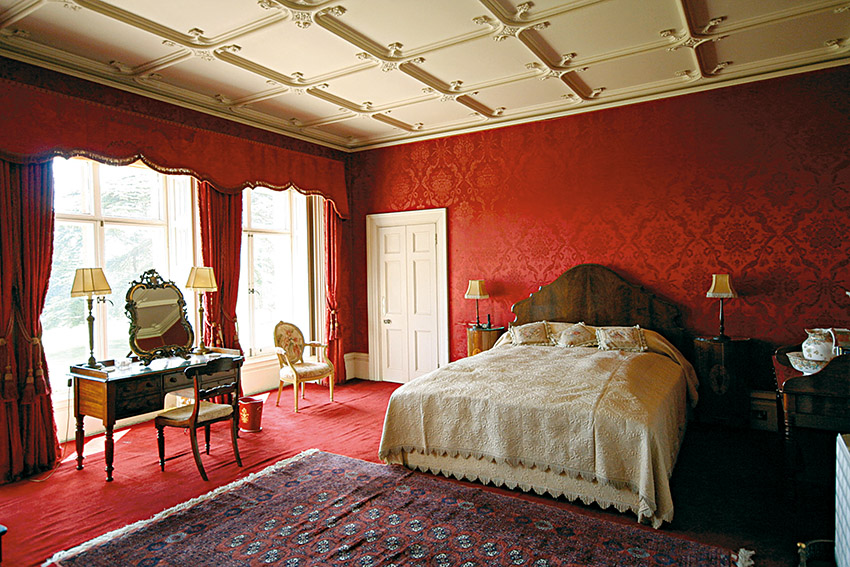
Highclere’s Stanhope Bedroom became Mr. Pamuk’s bedroom in Downton Abbey. Photo courtesy Highclere Castle
For the record, Mary’s bedroom and dressing room are actually a stage set and don’t exist in Highclere Castle. Neither do the kitchen and servants’ rooms. Downton Abbey’s entire downstairs is constructed in period style in the London studio.
The Saloon, Oak Staircase and Dining Room
The highlight of our Highclere Tour was the Oak Staircase leading from the Gallery-level bedrooms to the main part of the house. Ken and I paraded down the ornate-banistered staircase like Matthew Crawley and Lady Mary into a large room called The Saloon, the heart of this grand house—and a room that’s much featured on Downton Abbey. Its stone fireplace, carved cabinets, and arched doorways appear in famous scenes such as the Servants’ Ball and the concert for the soldiers. This spot just took my breath away.
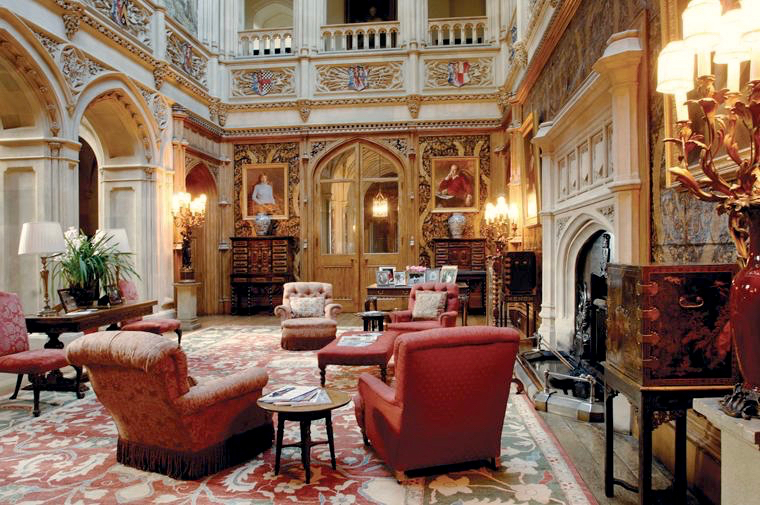
The elegant Saloon is overlooked by the Gallery. Photo courtesy Highclere Castle
It was delightful, also, to visit the Dining Room, where many an elegant meal—usually partaken of by the Dowager Countess, played by Maggie Smith—is filmed. It must be quite an experience for the present-day Carnarvons to sit at the table under the watchful gaze of the portraits of their ancestors.
Just as we left the main part of the house to go to the Egyptian exhibit, one of the guides asked whether we’d seen Countess Carnarvon, who had been walking through the rooms chatting with them just minutes before. Rats! We missed her. She was probably wearing jeans and blended in with the visitors.
Perhaps it’s just as well…I hadn’t practiced curtsying. But I can’t help thinking it would have been fun to say, “Good morning, Your Ladyship.”
—Laurel Kallenbach, freelance writer/editor
P.S. Many thanks to the Carnarvon estate for use of the photos of the interior of Highclere Castle. You can see slideshows of Highclere Castle photos at the castle’s website.
Originally posted: February 2013
Updated: March 2022
Read more Downton Abbey posts:
- King Tut Meets “Downton Abbey” at England’s Highclere Castle
- An Eco-Elegant English Hotel, “Downton Abbey” Style
- Bampton, England: Film Location for “Downton Abbey”
- Sweet Dreams at Downton Abbey
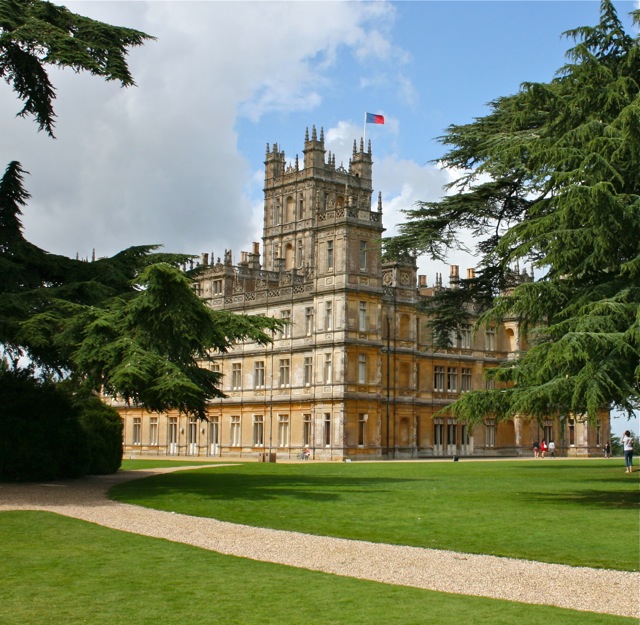
Highclere’s Georgian-era house was remodeled in 1849 and became the Victorian castle as it appears today. Architect Charles Barry built the spires in the style of London’s Parliament Building, which he also designed. © Laurel Kallenbach

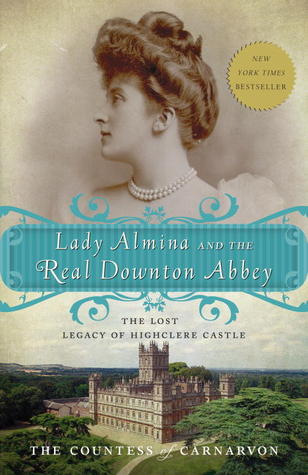
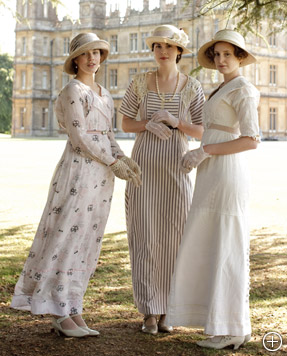
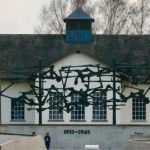
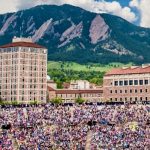
Thanks for sharing your tour of Highclere on your blog. I have now moved it higher up on my bucket list. I knew about that Lord Carnarvon was Howard Carter’s patron in the search for and excavation of King Tut’s tomb, but never made the connection between Tut and Downton Abbey.
Loved this Laurel–I am a fan of Downton Abbey too–so odd to indulge in all this splendor while sitting in my 2-room cement box in the bush of Africa.
Well, there’s man-made beauty like Highclere Castle, and there’s natural beauty like in Botswana! Both have their place!
Oh it’s absolutely drfadeul! Total soap-opera. And they stole the flower competition scene straight from Mrs Miniver. But it’s still a lot of fun and beautiful to look at
This was such fun to read! I LOVE Downton Abbey and my mom’s just about to watch it, so I’m sending her the link to your blog.
Oh, Bates! Oh, Anna! Loved “visiting” Highclere with you. Funerary pots used as umbrella stands kind of sums up the aristocracy, I think. Please tell me the tour concluded with relaxing in a tearoom, where you were served with bone china.
There is a tearoom at Highclere, but it was lunchtime, and we’d actually brought a picnic lunch with us. So we ate on the lawn outside Highclere—on a huge tree stump, which we saw in an episode from Season 2.
Thanks for writing about your visit. Like others who have commented, I had not made the connection between the Carnarvons of Highclere and Howard Carter until I read your post. A lovely bit of timing, as I am just embarking on a fiber art project using ancient Egyptian themes, and had just read again about Carter’s work.
Stay tuned for my next post, in which I will talk about the Egyptian exhibit some more. And good luck with the fiber art piece; sounds wonderful!
I loved your post, Laurel! We’ve only recently discovered the show and, like you and so many others, are enthralled by it. (We watched seasons 1 and 2 on DVD in record time.) How thrilling to have stood in the salon! Thanks for sharing some of the history and other rich details.
Yes, we loved the “saloon” (that’s the word the British use—although to Americans it sounds like a cowboy bar!). Perhaps “salon” sounds too French for the English aristocracy. At any rate, I wouldn’t mind having tea or a scotch in the salon/saloon at Highclere Castle!
Fascinating post–a lovely visit into another world so colorfully rich with history and personalities, thank you!
I’m so glad you reposted this. I re-read it just before the program started. Got me in the spirit.
Me too! And now we’re in the Roaring Twenties!! Full drama ahead!
Such interesting posts (this one and the King Tut link one). I’m just in the process of writing up two Downton Abbey posts and will definitely be linking to yours here for further reading. Thanks for such thorough posts.
New info on Lady Almina Carnarvon:
http://www.dailymail.co.uk/news/article-2546026/Why-real-World-War-One-heroine-inspiration-Downton-Abbey-refused-accept-CBE-work-caring-wounded.html
My husband and I watched all of Downton Abbey and loved it! We are heading to Highclere soon!!! Loved reading your notes before we leave home! Love your writings!
Enjoy the Highclere experience. You’ll love it! And thanks for reading!
I can’t wait to see the movie!